'Shoot directly': Hasina’s order and deadly aftermath

On the morning of July 27, 2024, Sheikh Hasina stood silently at the podium at the National Institute of Traumatology and Orthopedic Rehabilitation (NITOR), also known as Pongu hospital, in Dhaka.
For nearly 14 seconds of the eight-minute emotional speech, the deposed prime minister said nothing. Bitter pain etched onto her face, as if weighed down by the enormity of the bloodshed since July 16, the day police killed Abu Sayed in Rangpur using lethal weapons. Five more lives were lost that day in violence in Dhaka and Chattogram.
By the time Hasina stood at the NITOR podium, at least 162 people had been killed over the last two weeks, many of them gunned down with military-grade lethal weapons by state forces, according to The Daily Star's findings.
"I seek justice from my fellow citizens. What crimes have I committed to deserve this?" Hasina,77, said, after visiting some injured victims at the hospital.
"I don't want any mothers to lose their children like this. I've lost my parents, I know the pain…. So many lives have been lost, so many families have been destroyed. Who is responsible for all this?....I just watch all this and..." she said, and left the stage in tears without completing the sentence.
This moving public speech stands in stark contrast to what was unfolding behind the scenes. An investigation by The Daily Star now indicates that a state-sponsored massacre machine had already been set in motion.
Just nine days earlier, on the late evening of July 18, 2024, a phone rings inside the ousted prime minister's residence, Gonobhaban, and Sheikh Hasina answers. On the other end was Sheikh Fazle Noor Taposh, the then Dhaka South City mayor. What followed was a revelation of a deadly plan.
"We are now doing things differently. We are capturing photos with drones, and sending helicopters to several places," Hasina told Taposh, also her nephew.
"Wherever they [state forces] will see gatherings, there from the sky… I am having it done from the sky now, already started in several areas…. already started," she said, as Taposh is heard repeatedly insisting on launching a mass arrest campaign.
"I have given instructions, now I have given direct instructions; now they will use lethal weapons. Wherever they [state forces] find them [protesters], they will shoot directly," Hasina said, to which Taposh responded in agreement, "Yes, yes."
This was echoed by Awami League General Secretary Obaidul Quader the very next day, on July 19, although he did not name Hasina, who fled to India on August 5, 2024.
"The government has issued a circular. So it's definitely a curfew and there is also a 'shoot-at-sight' order," Quader told journalists while announcing the curfew.
The Daily Star obtained a call recording between Hasina and Taposh. The audio is one of many that were leaked on social media since March that involved conversations with Sheikh Hasina and were recorded by the National Telecommunication Monitoring Centre (NTMC). Parts of the same leaked audio was examined and reported by the BBC earlier this month.
The call recording has shed new light on Sheikh Hasina's alleged direct involvement in the brutal crackdown on the movement --revealing her explicit orders to use state forces to crush dissent at any cost.
After months of investigation, The Daily Star has uncovered previously unreported evidence, including official data of deployment of helicopters and lethal weapons, verified photos and videos, eyewitness testimonies, newspaper reports and expert analyses, confirming her instructions were carried out on the ground.
The Daily Star's tally during the uprising found that the death toll had risen from six to sixty-six between July 16 and July 19, underscoring the impact of Hasina's instructions.
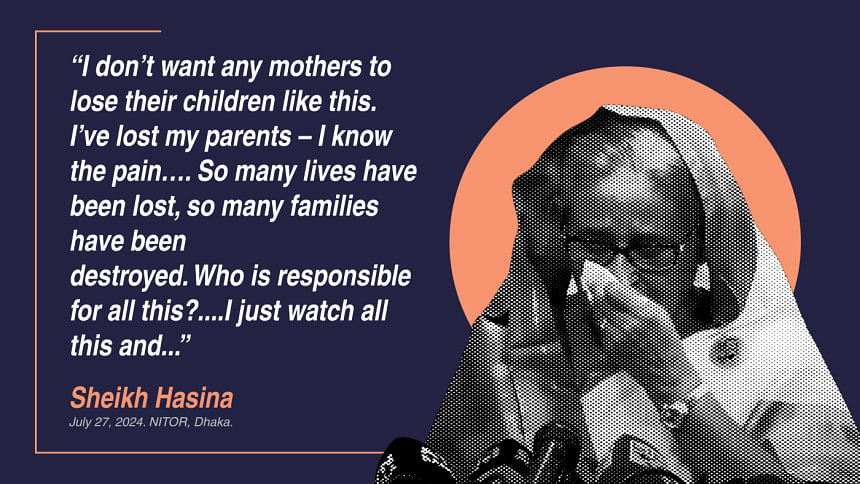
Our findings are in line with the UN's fact-finding report, released in February 2025, which also found evidence of use of excessive and lethal force by the Awami League government, its political leaders, and security forces.
Independent verification
The Daily Star conducted its own independent verification, and provided the audio to Tech Global Institute (TGI) --a technology nonprofit whose forensic investigations arm has been documenting digital evidence related to the July uprising --for technical analysis.

TGI ran a multi-layered forensic examination and found that the audio is highly unlikely to have been altered. Its analysis of the amplitude, tone, rhythm, intonation and breaths did not find any significant or detectable anomalies typical of synthetically generated media. TGI also conducted voice biometrics of the speakers, mapping the unique voiceprint of each speaker with publicly available audios of suspected individuals, and indicated that the speakers were most likely Sheikh Hasina and Fazle Noor Taposh.
TGI's technical analysis was corroborated by The Daily Star. This paper obtained documents showing that the call took place on July 18 and the receiver's phone number is registered with the Prime Minister's Office. Sheikh Hasina had been using the number since at least 2019, including during her foreign trips.
Taposh's number was verified from official documents, including the PID Telephone Guide 2021, Bangladesh Secretariat Telephone Guide 2023 and Metropolitan Chamber of Commerce and Industry, Dhaka, Telephone Guide 2025. Other official documents obtained by The Daily Star also confirm this.
Both numbers were found switched off during the investigation.

Asked about the call recording, Md Amir Hossain, Sheikh Hasina's state-appointed counsel, said the matter is sub judice and the time is not right to offer an explanation.
"This is a matter for the court. If such documents are placed before the court, then let me see. At this moment, I am not interested in making any comment on this issue," he told The Daily Star by phone.
Contacted, Awami League Joint General Secretary AFM Bahauddin Nasim told The Daily Star over the phone, "As long as Sheikh Hasina and Taposh do not acknowledge it, this audio cannot be seen as authentic. It is fabricated and AI-generated."
Nasim, believed to be outside the country, added, "It is misleading and intentional. This has been done with the ill motive of delivering a verdict before the trial."
Taposh is thought to abroad and could not be reached for comments.
Terror in the sky
One of the earliest signs that Hasina's directives were being carried out came from the sky.
At 2:10pm on July 18, 2024, some of the first helicopters took flight, according to official documents obtained by The Daily Star. This timing suggests Hasina had communicated the instructions to the security forces well ahead of the phone call.
In one of its earliest aerial support, helicopters were dispatched to rescue about 60 policemen trapped inside the Canadian University of Bangladesh in Dhaka's Badda area, where they were caught in a tense, hours-long stand-off with protesters that day.
Documents show that helicopters remained deployed for about seven hours on July 18, until around 11:00pm, circling over neighbourhoods to assess the situation on the ground.

Over the next four days, until July 22, helicopters from various security forces continued to hover over Dhaka, often late into the night. Aboard these choppers, especially those belonging to Rab, security personnel were equipped not only with crowd-control weapons such as gas guns and stun grenades, but also with lethal arms including shotguns and SMGs. (Weapons experts say these were likely 7.62 Type 56 SMGs.)
During this time, disturbing reports began to surface across the capital. People were dying inside their homes.
The Daily Star investigated three incidents resulting in a total of three deaths and two injuries in the capital's Dhanmondi and Narayanganj areas on July 19 and 20 amid intense violence. One individual was reportedly hit while on her sixth-floor balcony, two were struck on their fourth-floor balcony in a single incident and two were hit on the rooftop of their 10th floor building.
In each case, victims were struck with 7.62x39mm bullets that can be fired from Type 56-pattern semi-automatic rifles or 7.62x39mm automatic SMGs, according to experts who have seen the photos of the three bullets.
And in each case, surviving victims and witnesses said they saw low-flying helicopters around their buildings at the time and that no clashes were taking place in the neighbourhood during that period, effectively ruling out the possibility that the shots were fired from the ground.
'I panicked and ran'
One year after the incident, Aiman Uddin, a university student, still bears the trauma.
On the afternoon of July 19, he stood on the rooftop of their 10-storey building, as a "white drone" and a helicopter flew low around their building and along Mirpur Road in the Science Laboratory intersection.
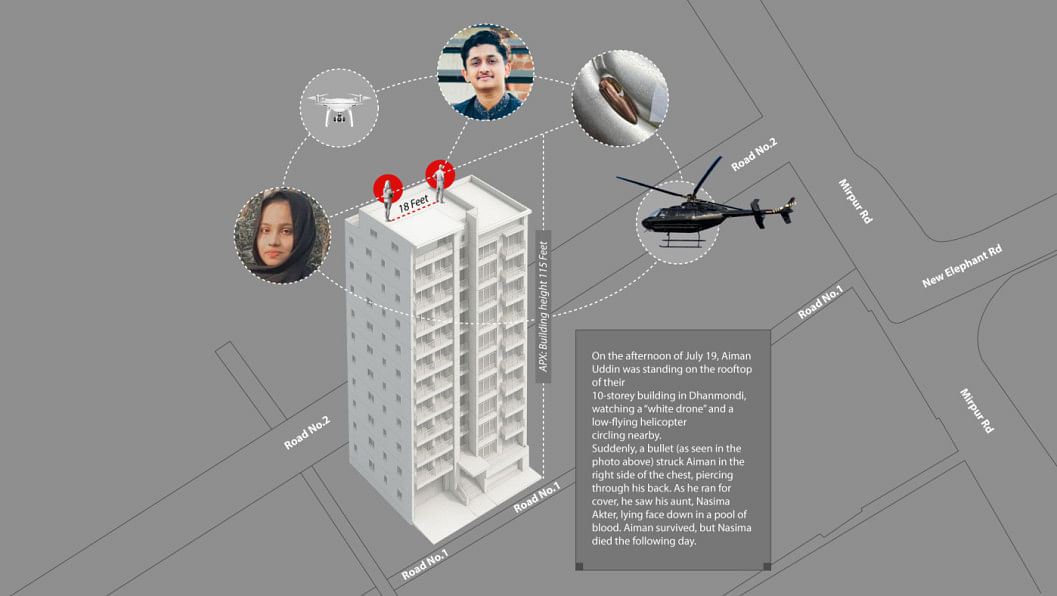
"Suddenly, a bullet struck my right chest and pierced through my back. I panicked and ran towards the staircase. But as I turned to flee, I saw my aunt lying face down," Aiman told The Daily Star in early July.
His aunt, Nasima Akter, had been hit in the face, right below her eyes. The bullet lodged in the neck. It was surgically removed, but she died the next day.
The Daily Star measured the distance between the two spots where Aiman and Nasima were standing: they were 18 feet apart, both positioned directly in the line of fire.
Our investigation -- based on the heights of the floors where the victims were struck, the trajectory and nature of impacts, accounts from at least 15 witnesses, combined with expert analyses -- indicates that none of these bullets came from the ground.
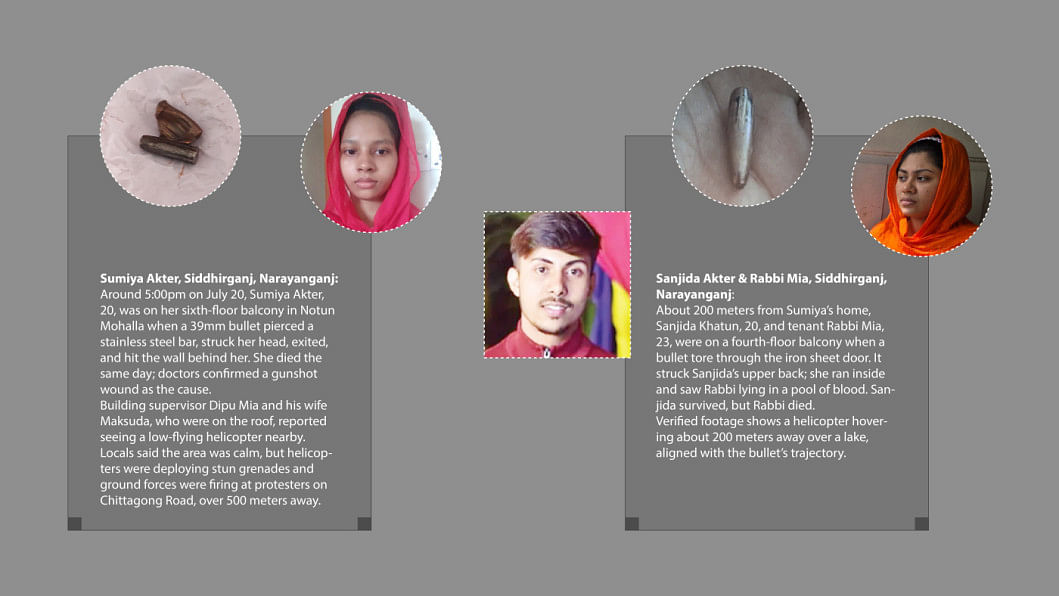
While The Daily Star has seen no direct evidence that bullets fired from helicopters hit these victims, witnesses were consistent about one thing: they all saw low-flying choppers nearby and firing in those fatal hours.
We collected photos of the three bullets involved in these incidents, in addition to videos and still images of the locations and their surroundings to understand the bullets' trajectory and angle of impact. We also collected videos and photos of flying helicopters from eyewitnesses.
The Daily Star shared the audio-video materials with the Tech Global Institute, whose forensic examination confirmed that the geolocation showing the route of the helicopters could be mapped to hovering around Sanjida Akther's building in Narayanganj, although it was not possible to confirm if shots were fired from them.
We also shared the photos of the bullets and videos of the locations with a retired Bangladesh army officer, who is an expert in arms-ammunition and ballistics.
"The images show 7.62x39mm bullets, and are typically fired from 7.62mm Semi-Automatic Chinese Rifles or from 7.62mm Automatic SMGs [AK variant]," said the expert.
"Given the bullets' trajectories and points of impact in all three cases, it's clear they didn't come from the ground. They could have come from other buildings or floors positioned at similar heights. But they could also have come from helicopters flying low 300-400 meters away; it's not impossible.
"When fired from SMGs or 7.62mm AK-pattern Chinese Rifles, their bullets, if unobstructed, can hit targets roughly about 1,500 meters away. Thereby, it can cause significant damage to softer targets like the human body," the expert said, requesting anonymity.

Documents verified by The Daily Star show that between July 19 and 21, Rab helicopters carried SMGs, among other weapons, daily – four on July 19 and one each over the next two days. Each day, they carried 60 rounds of bullets for SMGs.
Both in public statements during the uprising and in official documents obtained by The Daily Star, Rab denied firing from helicopters. In official records, it admitted charging 557 stun grenades and 985 tear shells from helicopters from July 19-21.
Previously, a Netra News investigation revealed that the death of a schoolboy on July 19 in Mohammadpur was linked to a stun grenade allegedly charged from a helicopter.
The massacre machines
Meanwhile, on the streets, lethal weapons were deployed in their thousands.
While law enforcement officers predominantly used non-lethal weapons such as stun grenades and gas guns in the early days of the quota reform movement, things drastically changed from July 19, in line with the instructions that Hasina allegedly gave, and admitted to, in the recording.
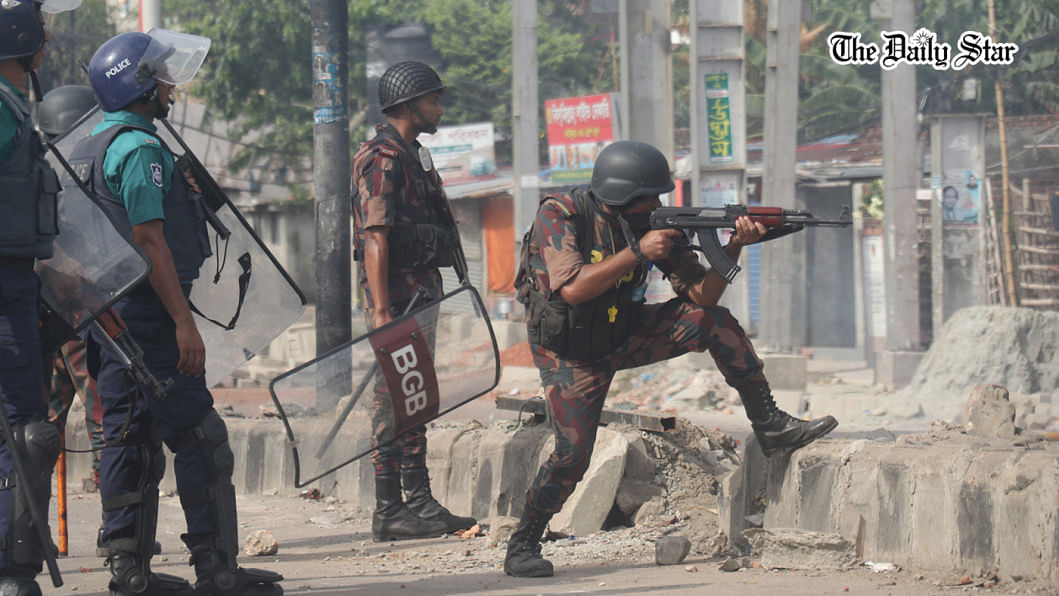
The chain of events following the call indicates the presence of necessary authorisation to use lethal weapons to suppress the protests.
The Daily Star's analysis of 20 verified photographs taken between 19 July and 5 August 2024, sourced from photojournalists of this newspaper, as well open-source investigation involving publicly available footage from TV stations, social media, and eyewitnesses, shows that in almost every instance, law enforcement agencies were equipped with military-grade weapons.
The state forces' arsenal included automatic and semi-automatic rifles, light machine guns, machine guns, Chinese semi-automatic 7.62mm Type 56 assault rifles, and handguns, as identified and confirmed by two weapons experts who have seen the photos.
Such weapons are typically used in violent wars, and with limited to no justification for use against civilian unrest, according to an international military expert who has seen some of the photos and videos.
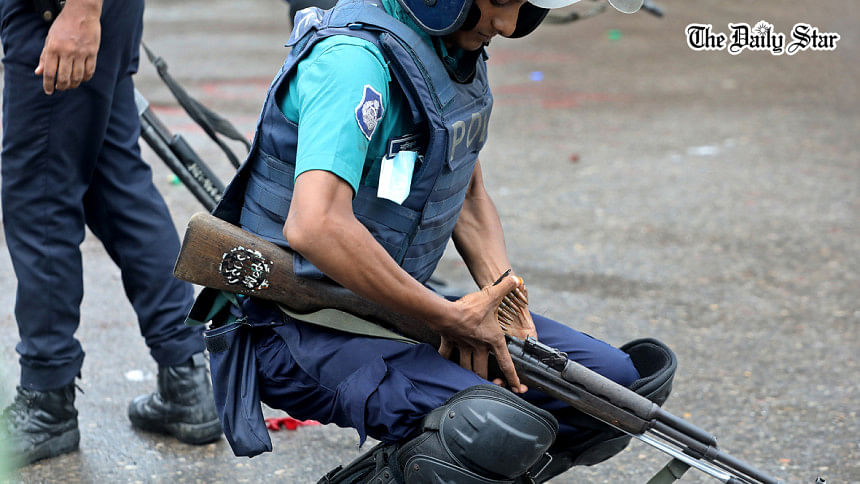
The nature of injuries and the cause of deaths of dozens of victims also clearly indicate that they were shot with heavy weapons designed for lethal force, not for crowd control.
The use of lethal weapons on key dates corresponds with mounting death toll.
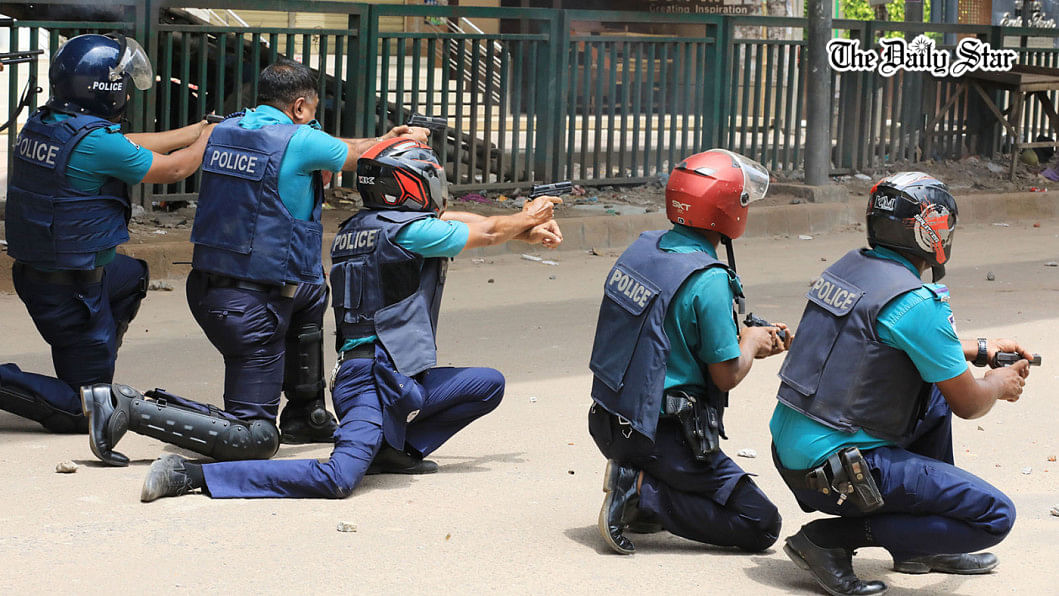
The Daily Star's investigation found that July 19 was the deadliest in that month, with at least 66 killed in a single day. The second deadliest day that month was July 20, with at least 30 people faced with fatal shots. (These counts are based on The Daily Star's real-time tally, which may vary from other estimates and reports.)
On both days, some of the highest casualties were recorded in Dhaka's Jatrabari, Rampura, Badda, Mohammadpur and Mirpur, where The Daily Star reporters and photographers documented use of lethal weapons by police, Rab, BGB and Armed Police Battalion.
One shot for one kill
Hours after Hasina disclosed to Taposh that she gave shoot-on-sight order, Ramzan stood at the entrance of Rampura Wapda Road among a small group of protesters on the morning of July 19, 2024.
He posed no visible threats -- he was not carrying any sticks or hurling any brickchips, the most common "weapons" protesters used in numerous cases.
At 9:50am, a gunshot rings out, and Ramzan, 24, collapses, a single bullet having pierced his neck, according to geo- and chrono-located video footage that have been forensically analysed by The Daily Star and Tech Global Institute.
The video captured the moments before and after his death. Moments after he was shot, the video shows fellow protesters rushing to drag his body away, leaving a smear of blood on the road.
In the background audio, a woman shrieks, "Allah… he is dead. Why did they do this? Allah, the way they aimed and killed the boy!"
Our joint investigation with the Tech Global Institute of the video footage shows Ramzan was shot from the front, where a contingent of 27 BGB personnel was positioned. At least 18 of them were carrying Chinese-made Type 56 and Type 56-1 assault rifles, none of which has non-lethal cartridges in service in Bangladesh in this calibre.
In other words, these are lethal weapons, and the distance and wound were found to be consistent with a high-velocity shot from rifles like the ones BGB members were carrying.
A closer analysis of the video footage, coupled with analysis from an international weapons expert, signals that the personnel holding and using the weapons received specialised training.
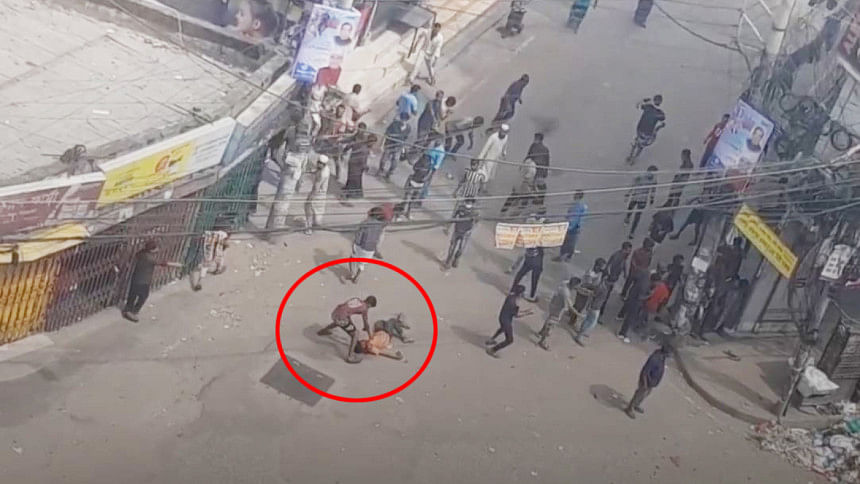
Experts further added that this shooting event was excessively dangerous and irresponsible and there is no justification for the use of lethal firearms during such highly dynamic unrest.
But killings like Ramzan's with lethal weapons were not isolated incidents.
Based on an analysis of the injuries of 204 victims, The Daily Star found that 195 (95 percent) of them were killed by mostly lethal bullets, including live rounds, shotgun pellets and rubber bullets. Of them, 113 were shot by live rounds that struck mostly in the head, chest, stomach and abdomen.
Even a single gunshot to these vital parts of the body can kill in minutes.
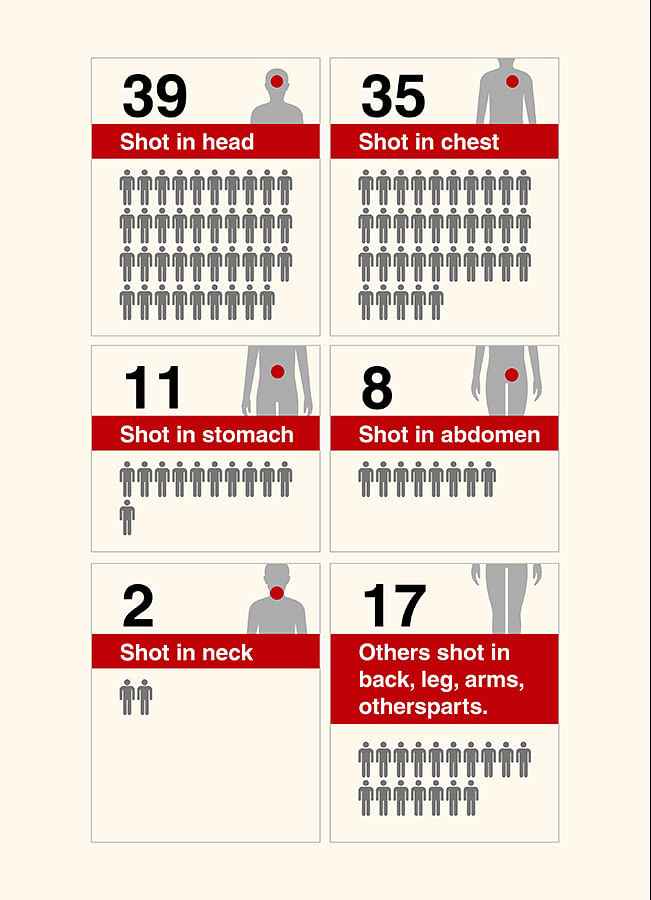
Maj Gen (retd) ANM Muniruzzaman said handling lethal weapons, such as those used during the uprising, requires two types of training. One is technical skill, which involves learning how to operate the weapon. The other, more crucial, is ethical training which teaches applying judgement in their use.
"And the hardest part of training someone with such weapons is this: knowing exactly how tightly your finger should rest on the trigger. They must be trained so they don't become trigger-happy," Muniruzzaman, also president of Bangladesh Institute of Peace and Security Studies, told The Daily Star.
Referring to the use of such lethal weapons by forces like police and Ansar, the security expert said, "Perhaps they received some basic operational training at the beginning. But they weren't taught to approach it from a position of responsibility. And that's evident from the casualty count."
But the most critical issue here is the Rules of Engagement, he said, adding, "This essentially means that the instruction to use lethal weapons came from higher command. Without such orders, the security and police forces could not have acted the way they did."
The Daily Star could not trace any such written order, but Sheikh Hasina's July 18 phone conversation is just one example of how and where that order might have come from.
Additional reporting: Mashfiq Mizan, Keero Adhnan Ahmed, Mahmudul Hasan, Saurav Hossain Siam and Sahidul Islam Nirab; Data: Muhammad Imran; Graphics: Anwar Sohel
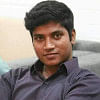
 For all latest news, follow The Daily Star's Google News channel.
For all latest news, follow The Daily Star's Google News channel. 

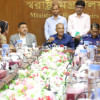

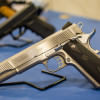
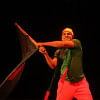
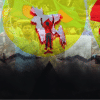
Comments